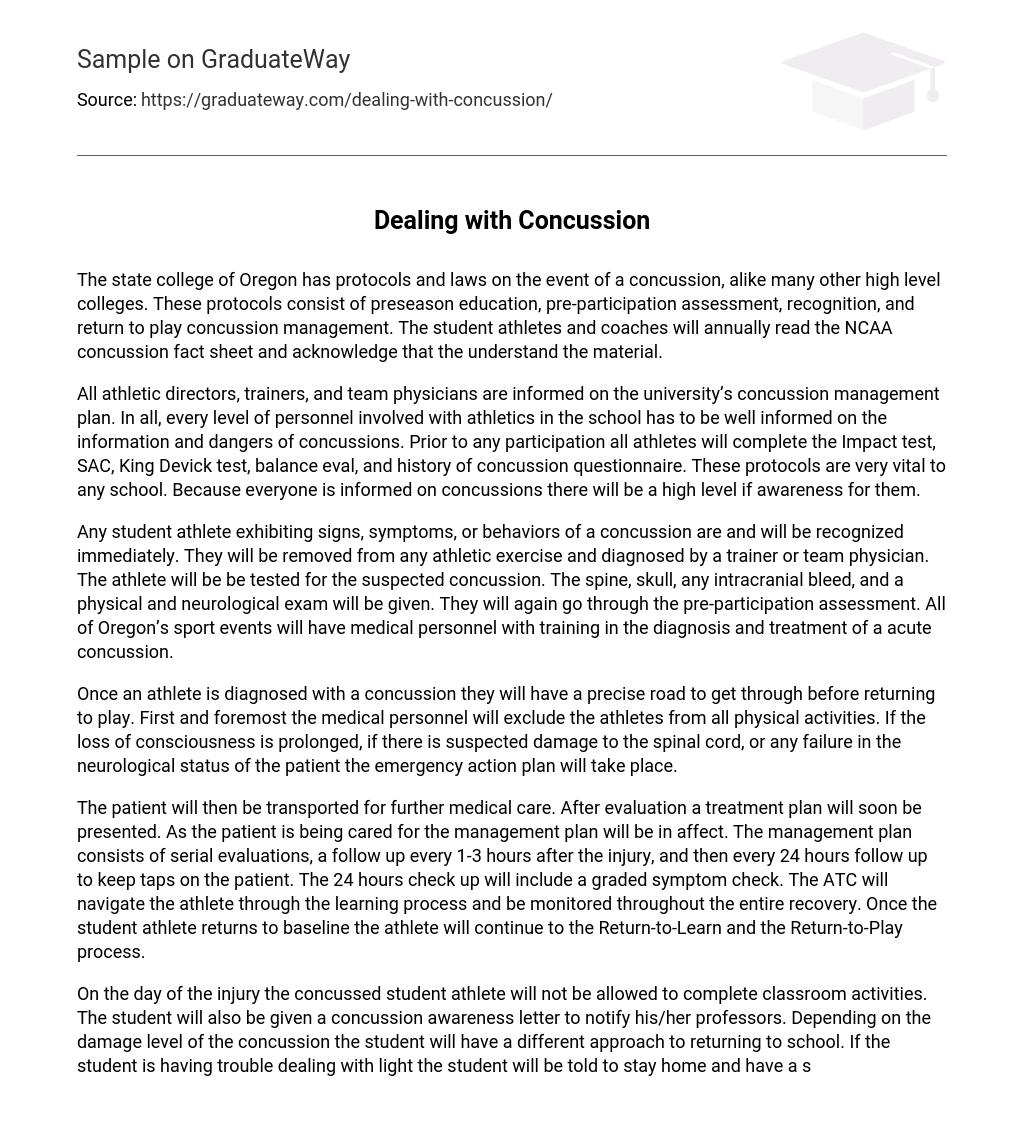The state college of Oregon has protocols and laws on the event of a concussion, alike many other high level colleges. These protocols consist of preseason education, pre-participation assessment, recognition, and return to play concussion management. The student athletes and coaches will annually read the NCAA concussion fact sheet and acknowledge that the understand the material.
All athletic directors, trainers, and team physicians are informed on the university’s concussion management plan. In all, every level of personnel involved with athletics in the school has to be well informed on the information and dangers of concussions. Prior to any participation all athletes will complete the Impact test, SAC, King Devick test, balance eval, and history of concussion questionnaire. These protocols are very vital to any school. Because everyone is informed on concussions there will be a high level if awareness for them.
Any student athlete exhibiting signs, symptoms, or behaviors of a concussion are and will be recognized immediately. They will be removed from any athletic exercise and diagnosed by a trainer or team physician. The athlete will be be tested for the suspected concussion. The spine, skull, any intracranial bleed, and a physical and neurological exam will be given. They will again go through the pre-participation assessment. All of Oregon’s sport events will have medical personnel with training in the diagnosis and treatment of a acute concussion.
Once an athlete is diagnosed with a concussion they will have a precise road to get through before returning to play. First and foremost the medical personnel will exclude the athletes from all physical activities. If the loss of consciousness is prolonged, if there is suspected damage to the spinal cord, or any failure in the neurological status of the patient the emergency action plan will take place.
The patient will then be transported for further medical care. After evaluation a treatment plan will soon be presented. As the patient is being cared for the management plan will be in affect. The management plan consists of serial evaluations, a follow up every 1-3 hours after the injury, and then every 24 hours follow up to keep taps on the patient. The 24 hours check up will include a graded symptom check. The ATC will navigate the athlete through the learning process and be monitored throughout the entire recovery. Once the student athlete returns to baseline the athlete will continue to the Return-to-Learn and the Return-to-Play process.
On the day of the injury the concussed student athlete will not be allowed to complete classroom activities. The student will also be given a concussion awareness letter to notify his/her professors. Depending on the damage level of the concussion the student will have a different approach to returning to school. If the student is having trouble dealing with light the student will be told to stay home and have a slow and gradual return to school. If the injury is prolonged the student’s academics will be assisted or modified so help the concussed student athlete.
Extra campus resources will also be provided through the year. The ATC will supervise the progression of the athlete and track whether the athlete can return to play. A minimum of 24 hours after the concussed student athlete has returned to baseline the Return-to-Play progression will begin. If the sign or symptoms of the concussion return activity will be completely cut. Once again the athlete is tested and evaluated for extra precautions. Through each step the patient can only advance if he/ she passes with no concussion like symptoms. Taking these extra precautions and monitoring the concussed patient will lead to a quick, successful recovery.
Vanderbilt University has similar rules to Oregon, despite being a smaller collage. Before the season everyone involved in athletics are informed on the dangers of concussions, and every athlete is required to take the baseline test. Also alike Oregon, Vanderbilt will have the athlete immediately removed and ran through a long course of steps to return to play. The biggest difference with Vanderbilt’s protocols contrasted against Oregon’s is that they will have one person decided to the cussed athlete instead of a team or pair like in Oregon.
One school with preferably the best protocols, Stanford University, is pretty different that most school. Every athlete, before athletic activity, must complete and pass an entire course. They also must understand of a high level that they are responsible for reporting their own injuries. On top of this they will have to complete the pre-participation assessment and the baseline test. Stanford has very good connects to give very advanced equipment and authority to treat the concussed athlete.
Although this is a top school it shares similarities with Vanderbilt and Oregon. These include the ending of activity when symptoms occur, and a long monitored and well tested concussion management process. All of these schools take concussions very seriously. They all know the dangers of them and make sure their student athletes are well cared for.
For the most part Oregon has amazing protocol and state of the art assessment teams. Everyone plays a role in preventing injuries and being watch dogs for concussions. At Oregon everything dealing with concussion is acknowledged.





